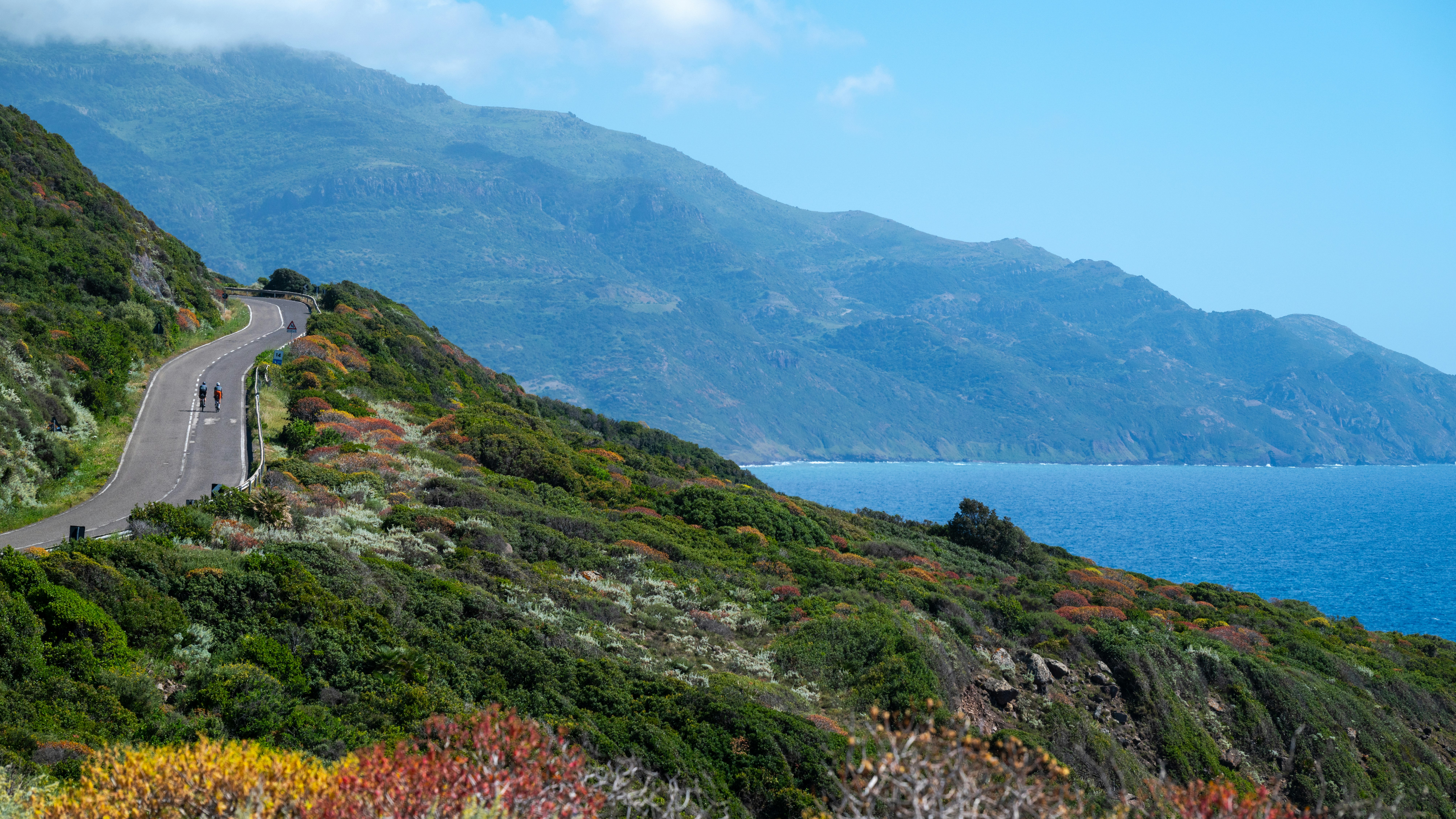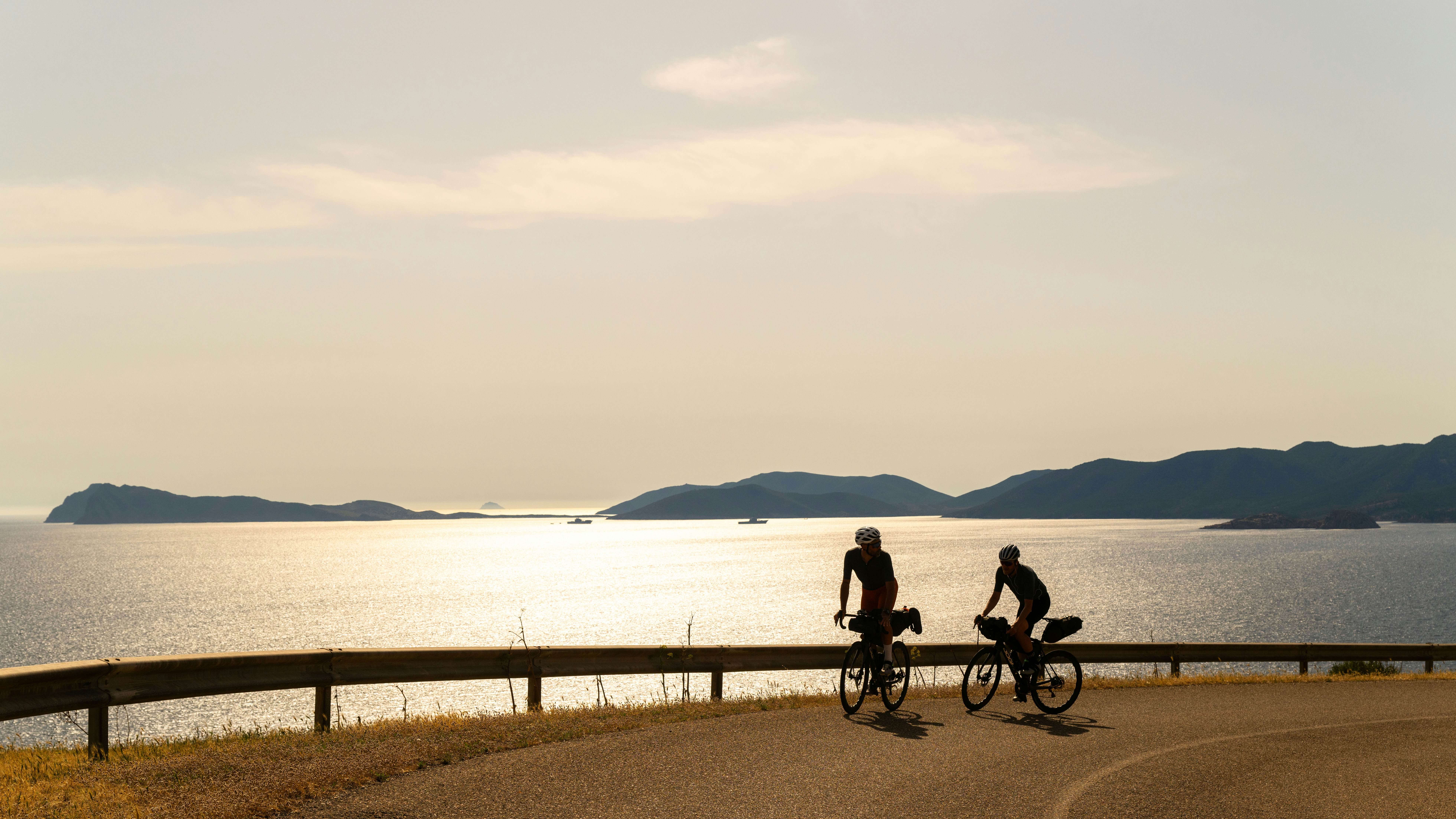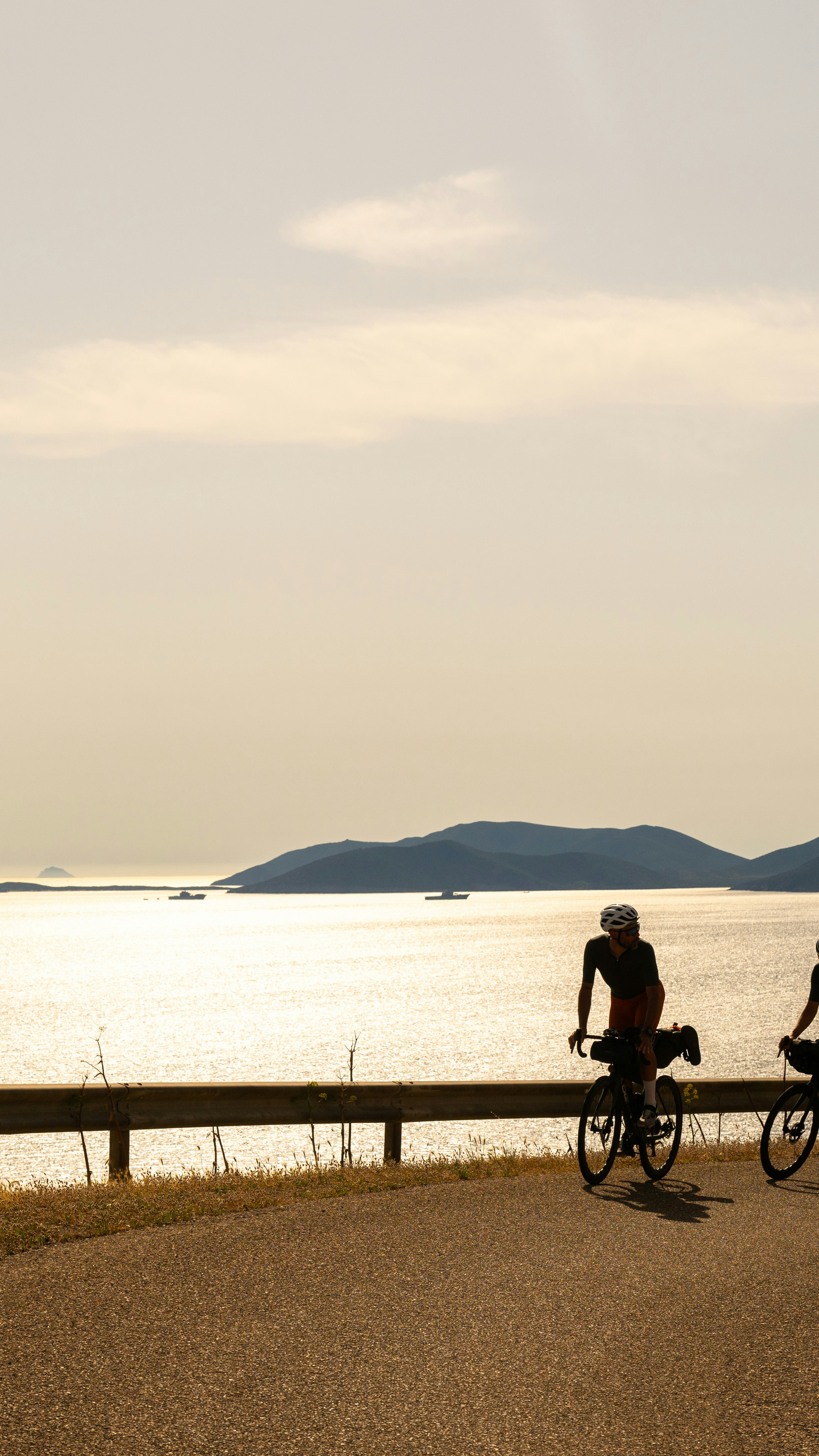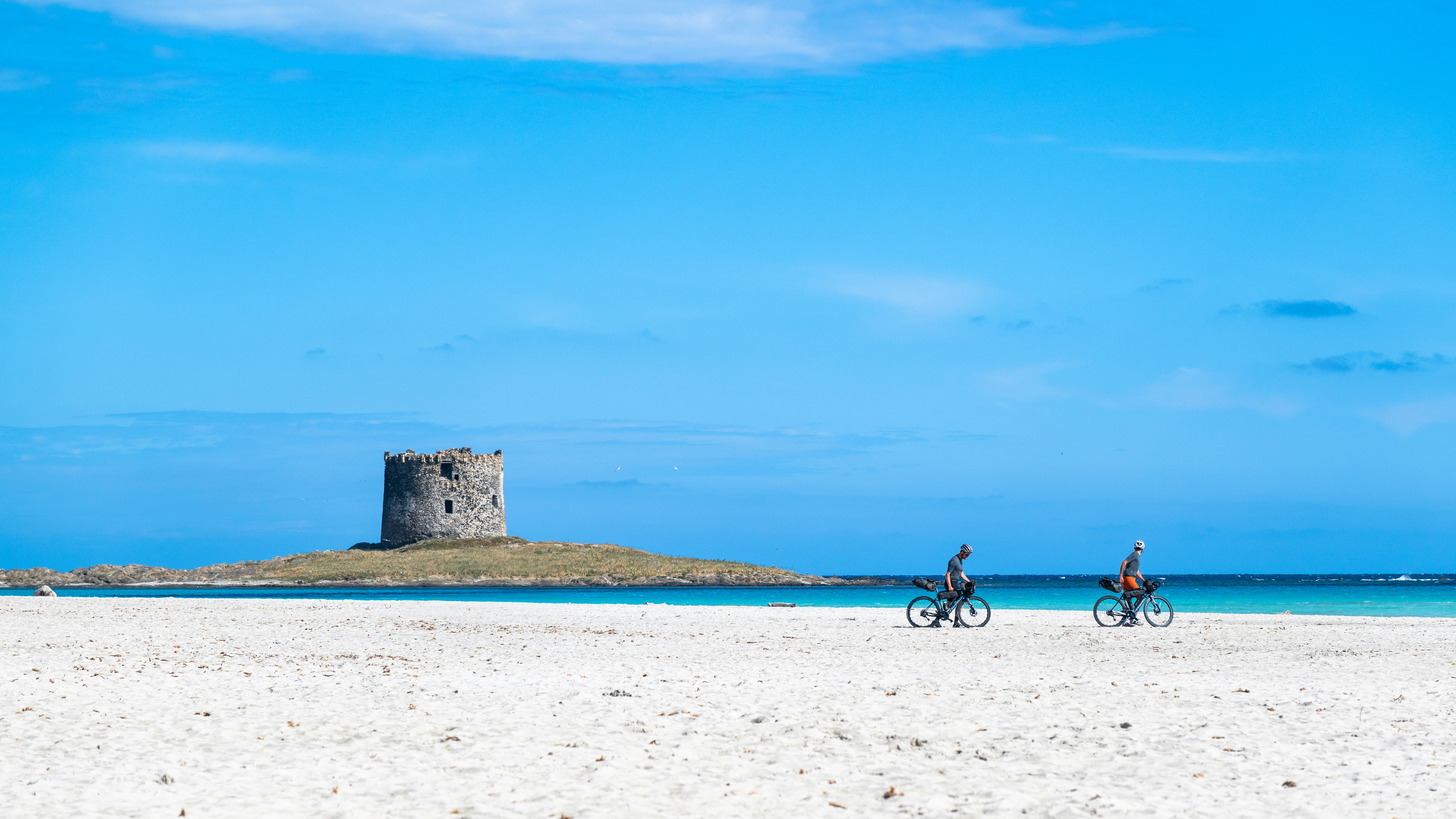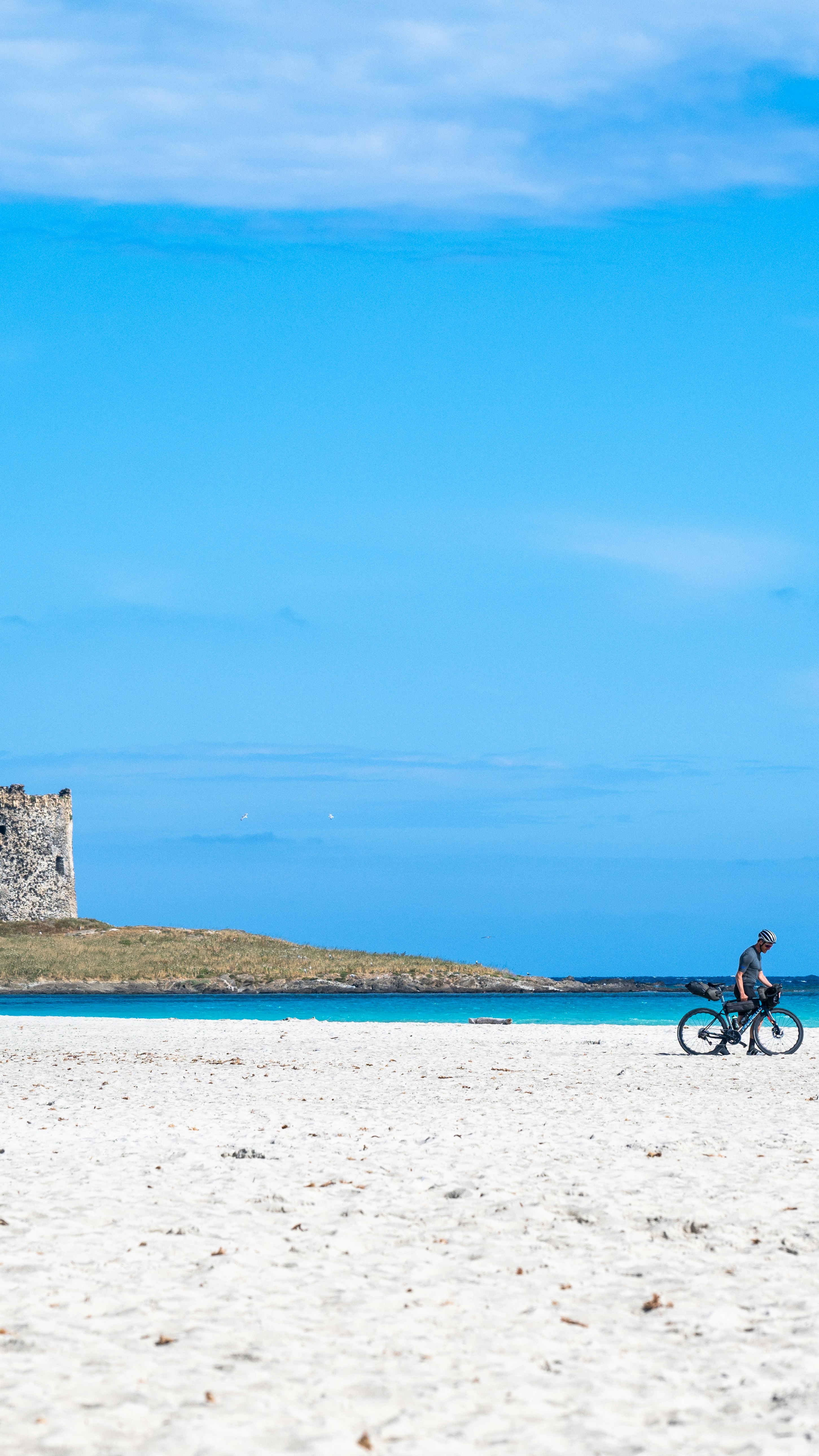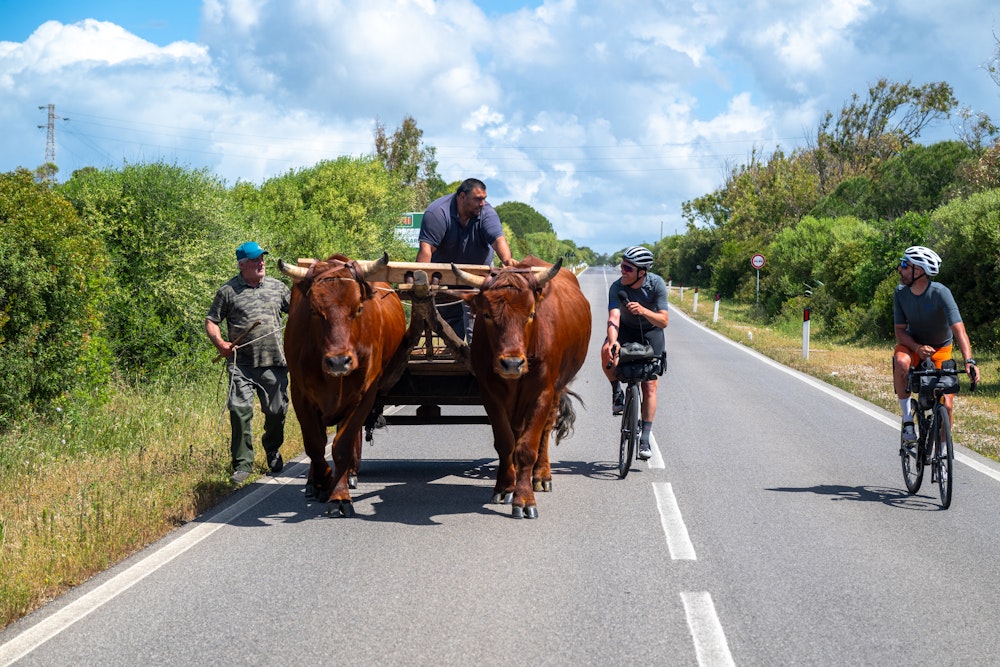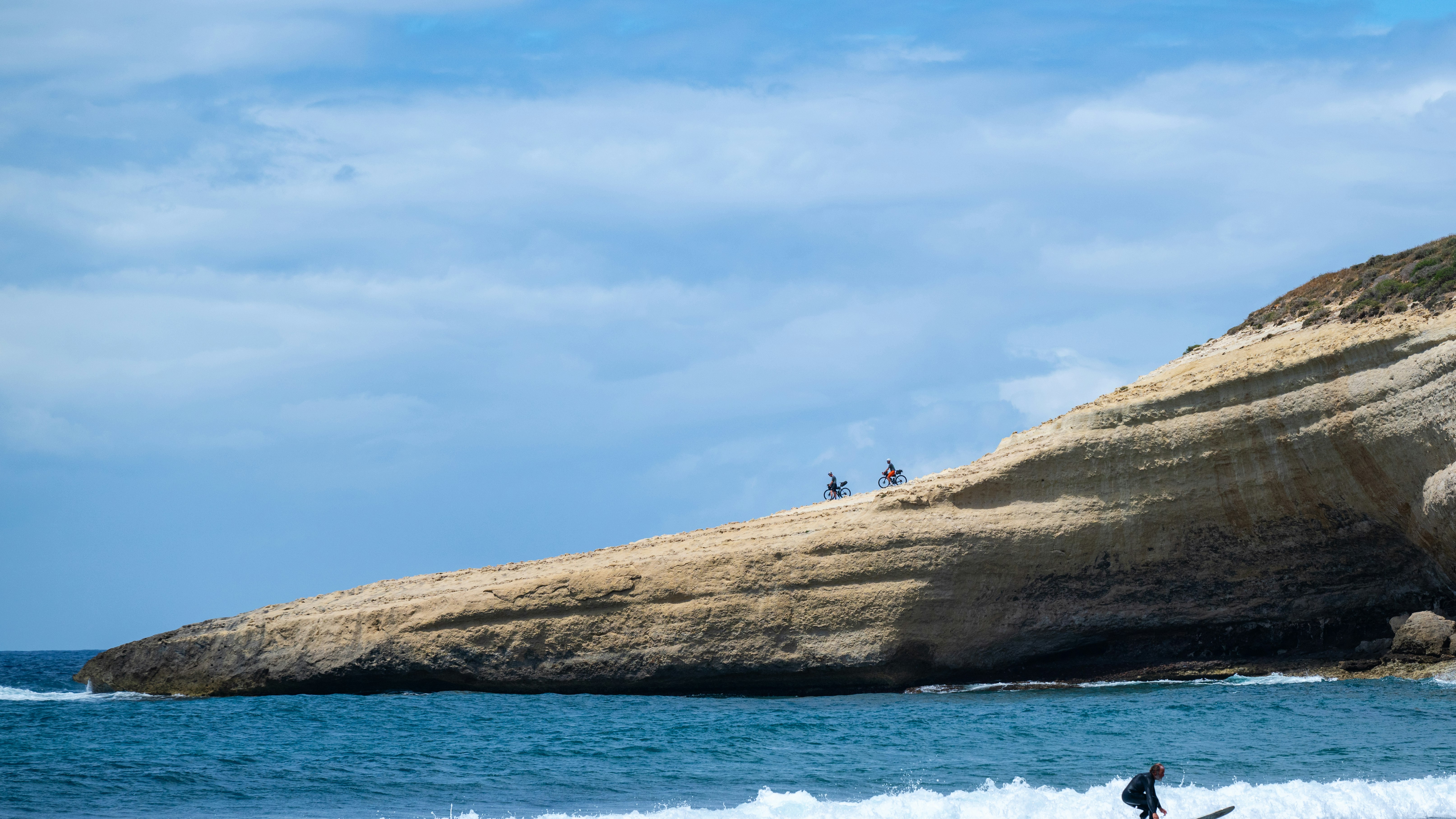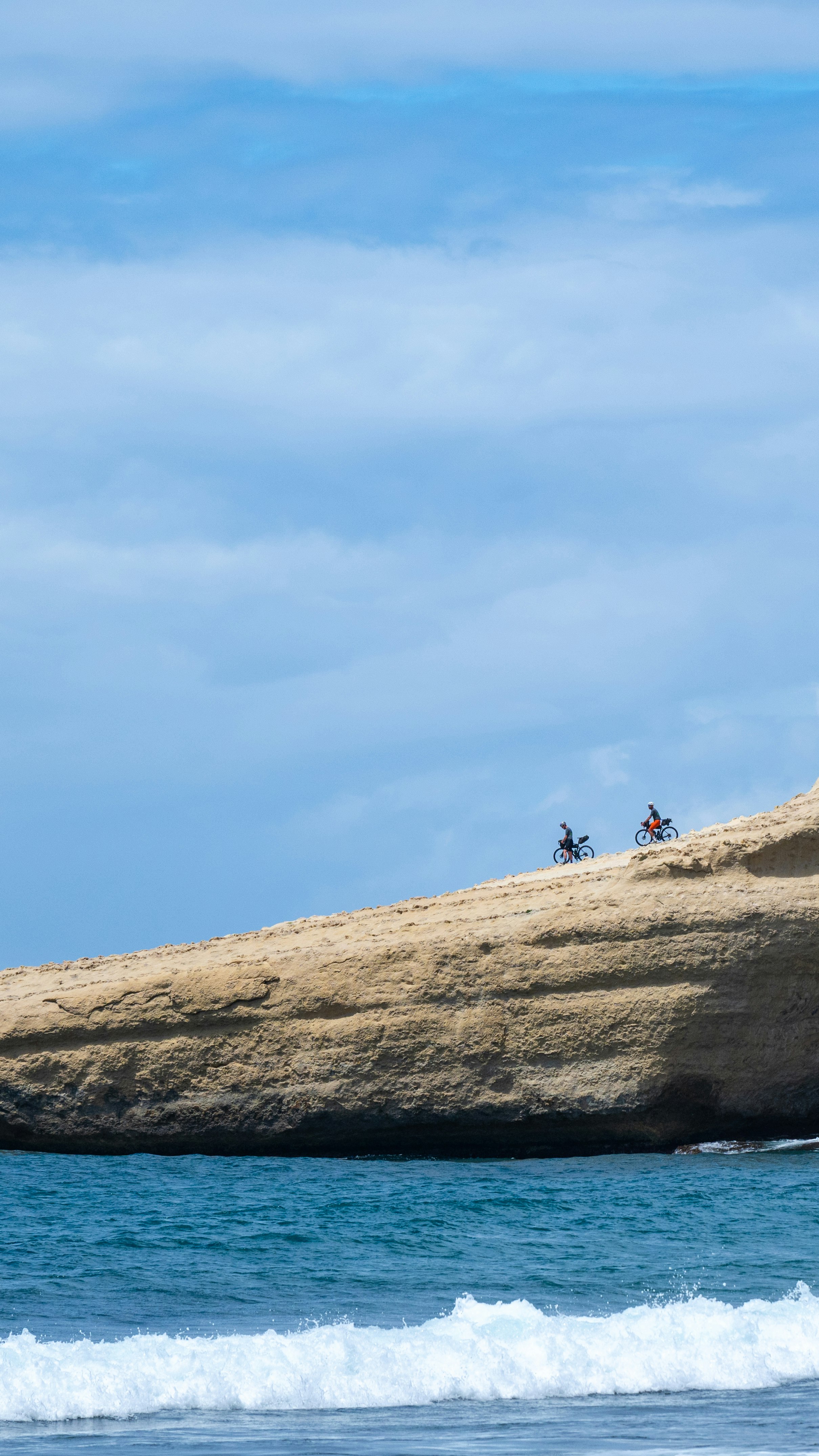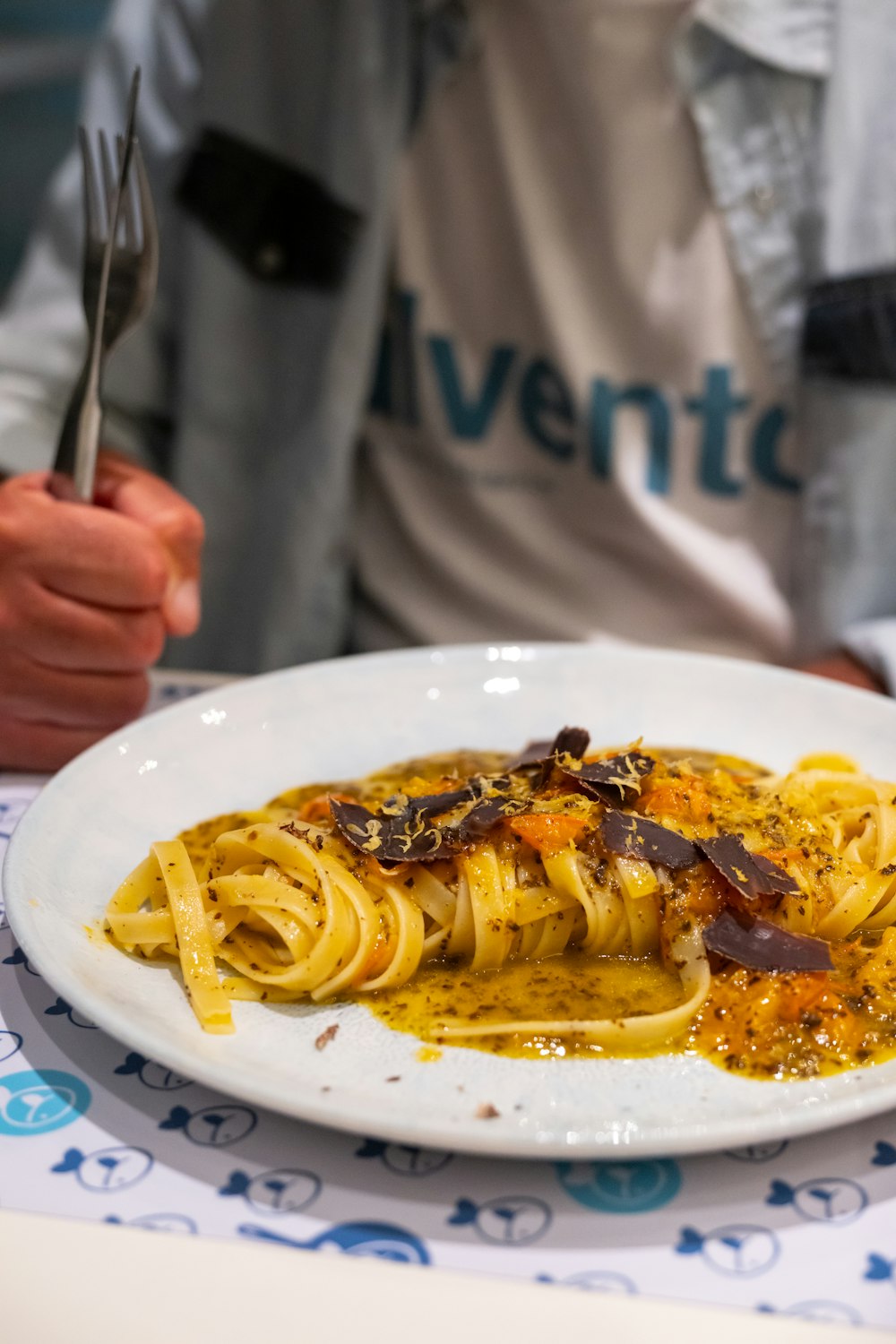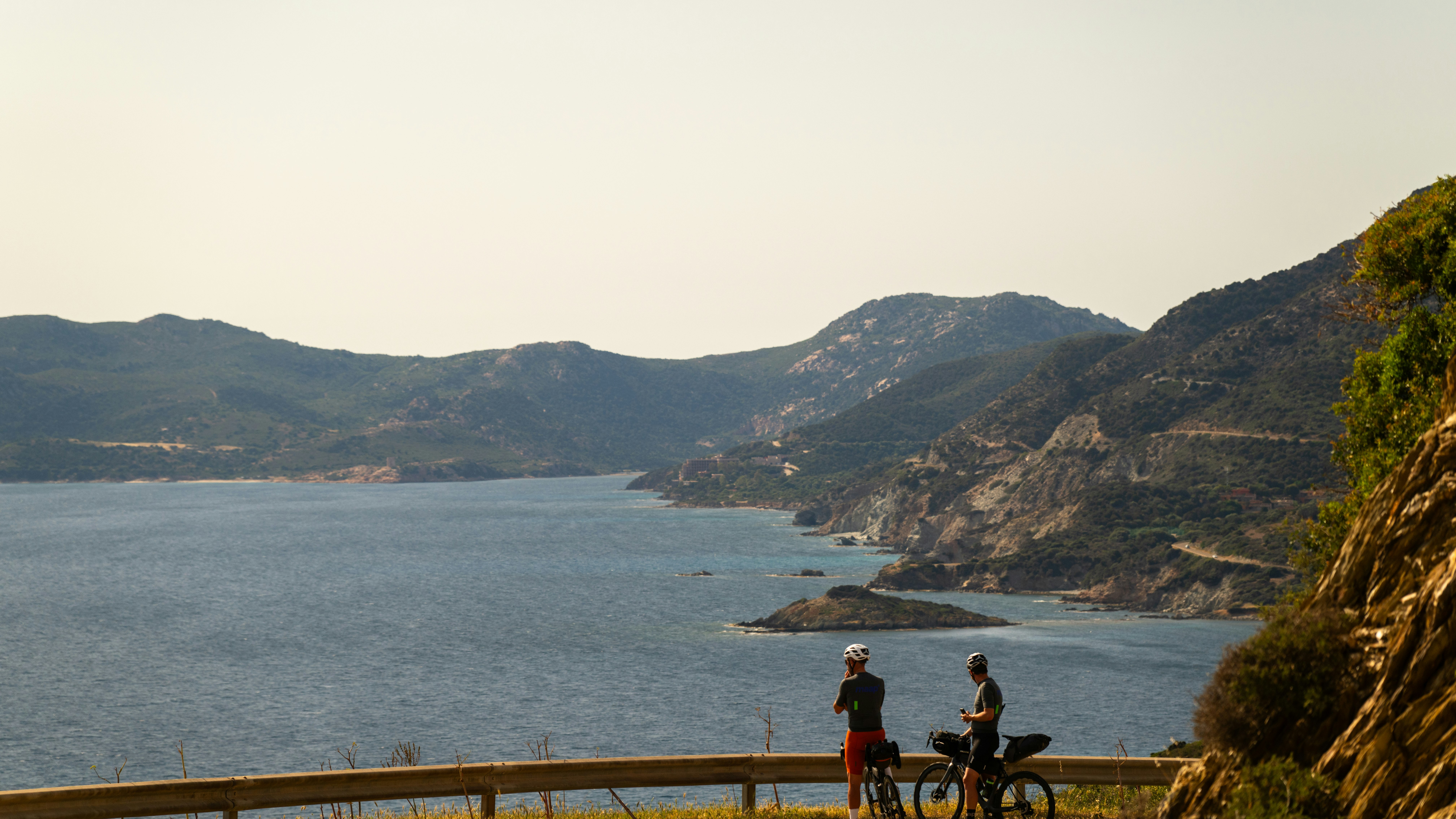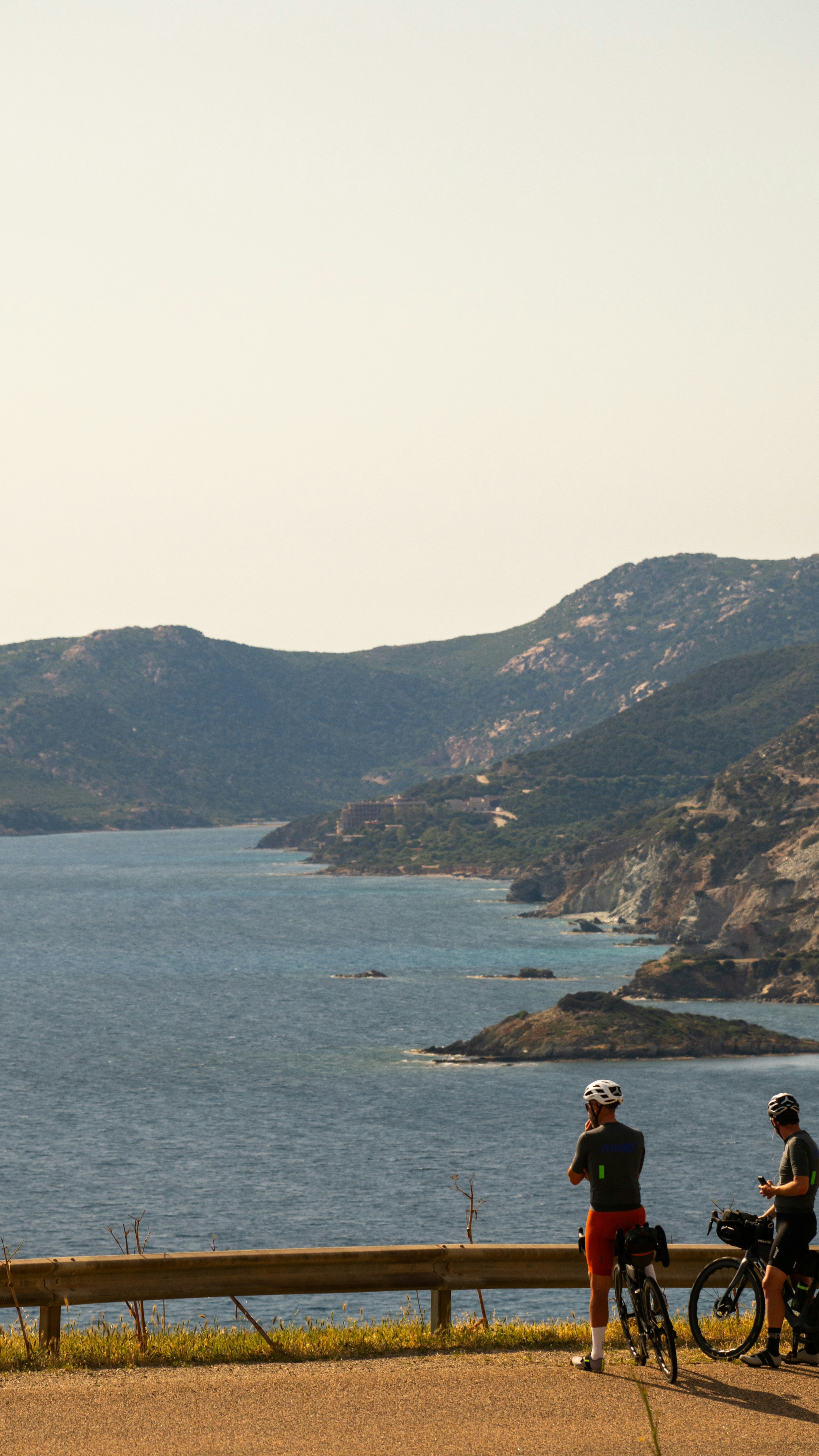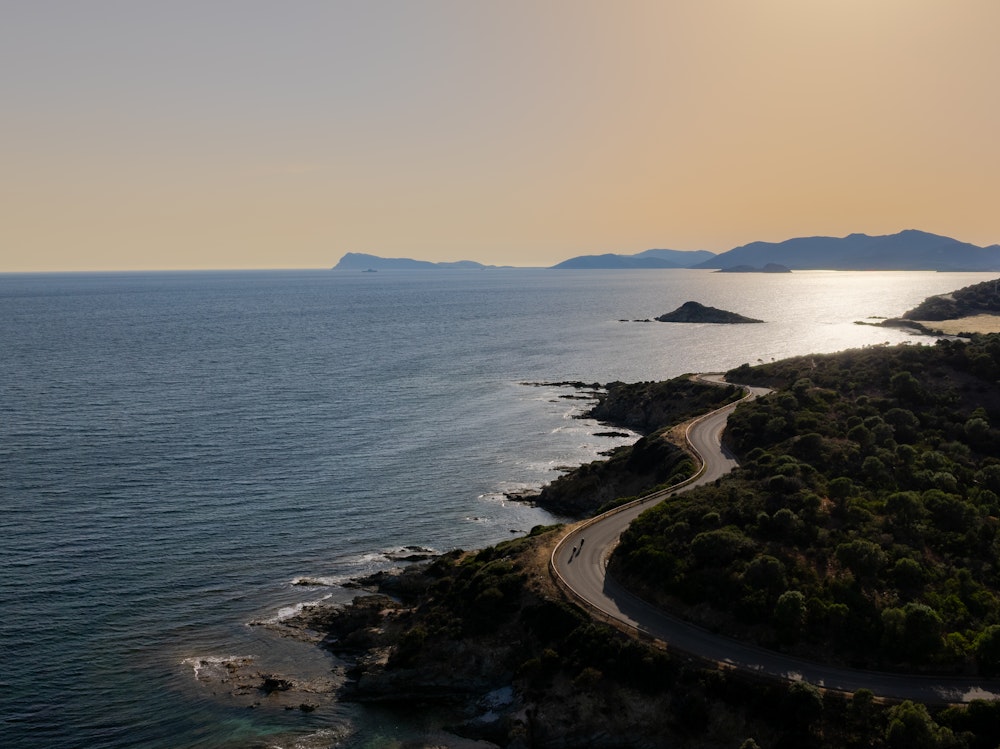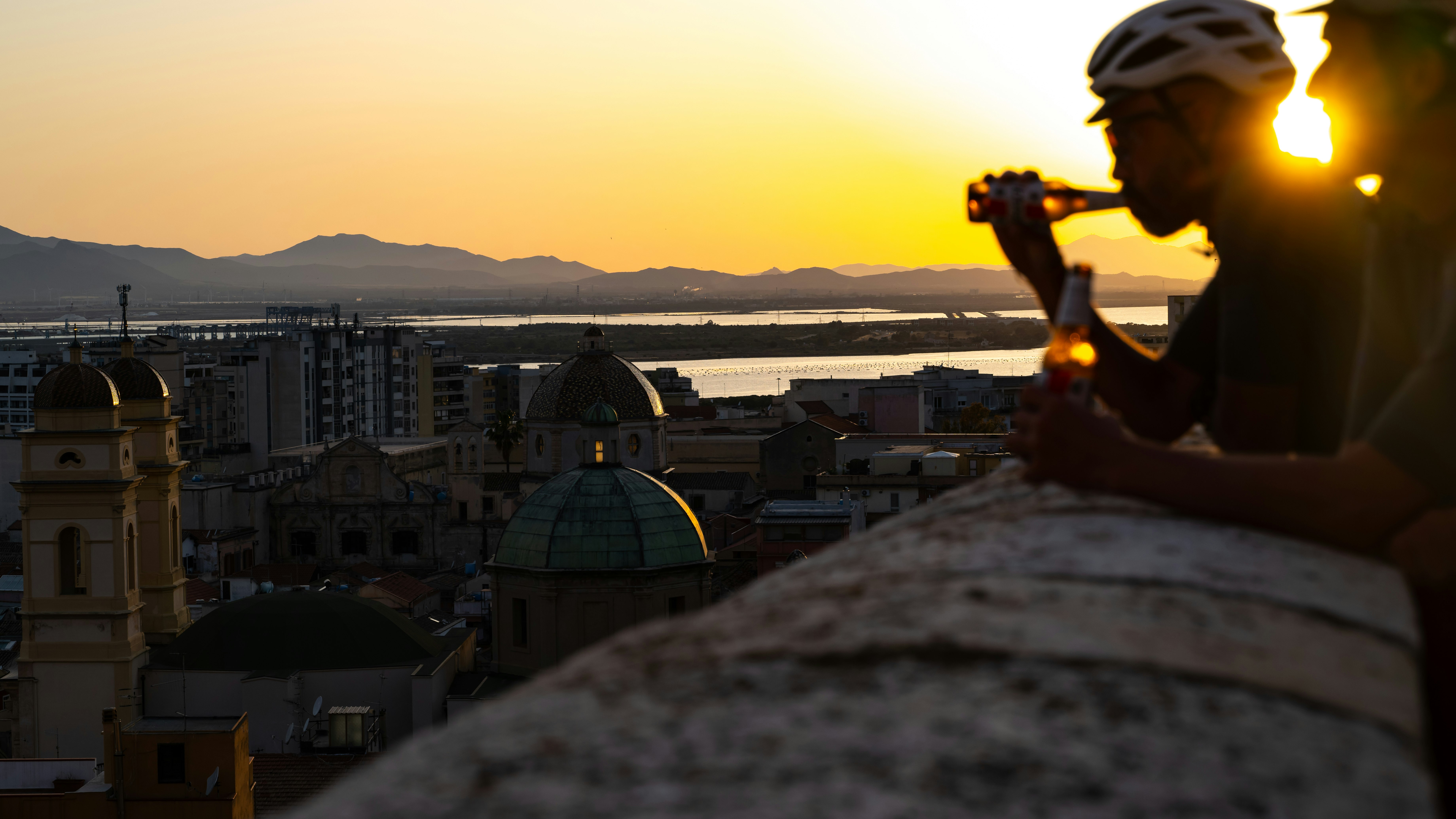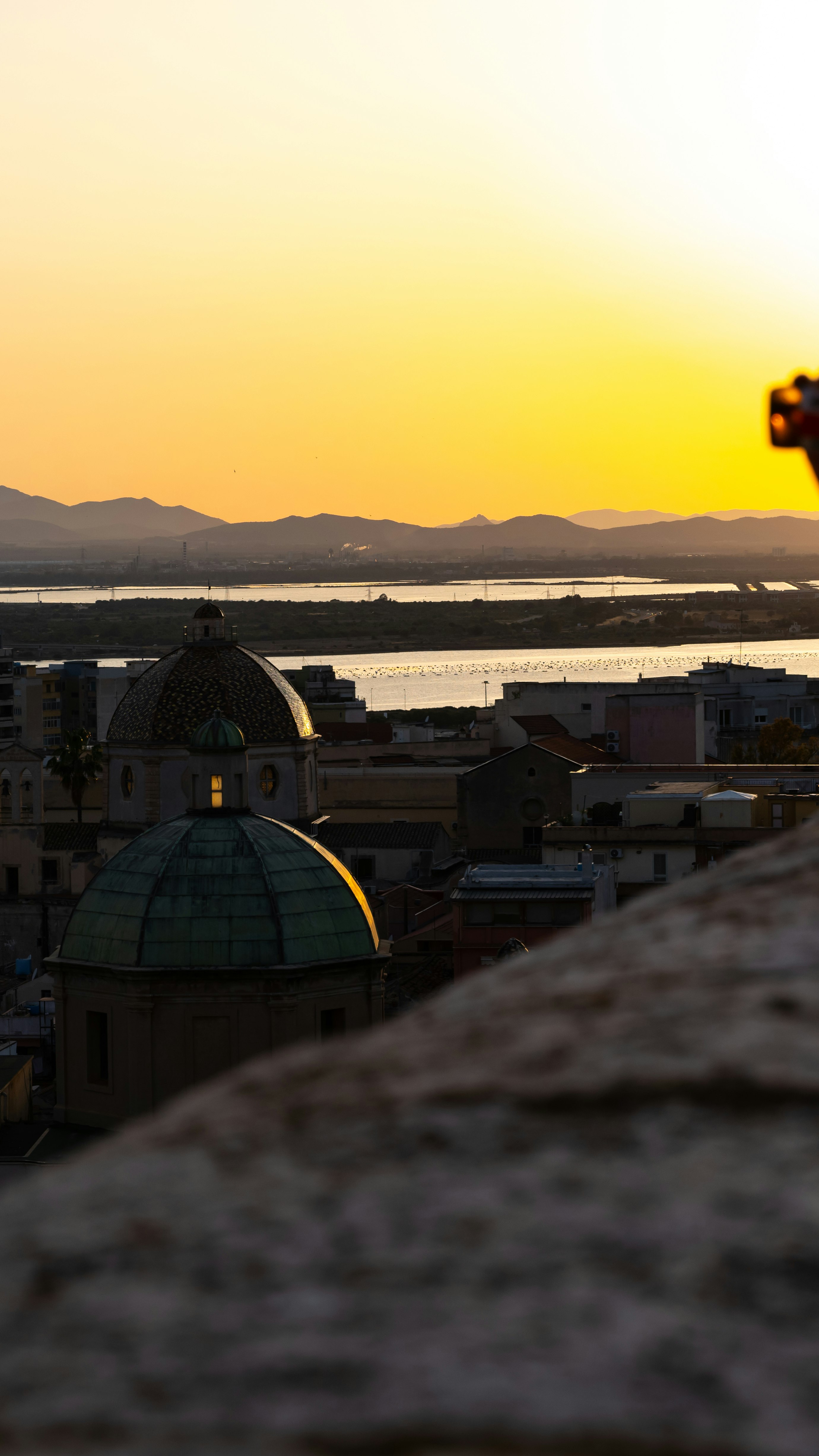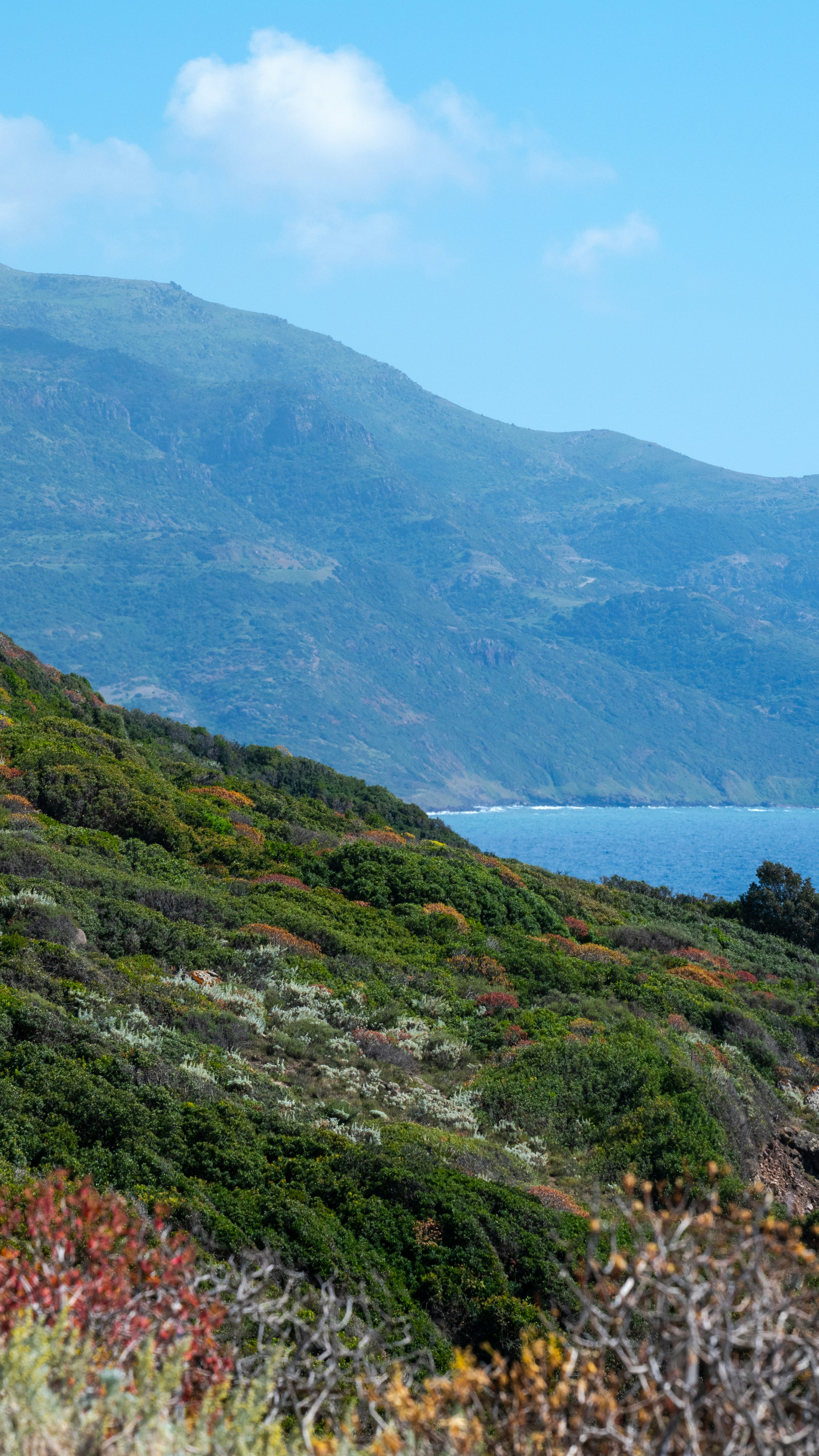
Far West
Sardinia is the exotic destination that is just around the corner. Going there gives you that sense of travelling, in the most authentic meaning of the word.
Period
Jan - Dec
Elevation difference
4132 m
Total Length
486 km
Duration
4/7 Days
I
Some years went by, communication evolved, everything changed. Footballers, showgirls, politicians of all stripes, actresses and actors: the island began to acquire a totally distant aesthetic from the one that had become fixed in me, losing that mythological charm and becoming a simple, yet splendidly scenic, land of toys. I think it was this change in my imagination that prompted me, more than anything else, to find two friends, embark, and choose to go there, to the deep west Sardinia.
Taking a ferry was a forced choice, but one that we accepted willingly. Of course, flying saves time, but the ferry allows you to be ready to ride the moment you embark. Our panniers already mounted on our bike frames, no problems with lost luggage and other mishaps, knives, canisters and accessories of all kinds are in tow and no airport controls.
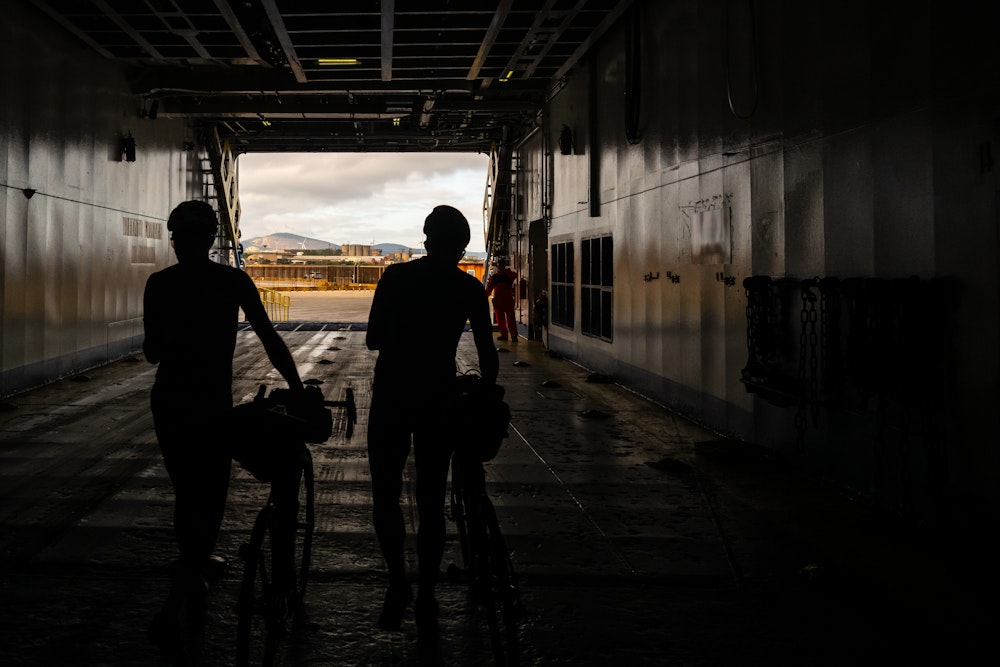
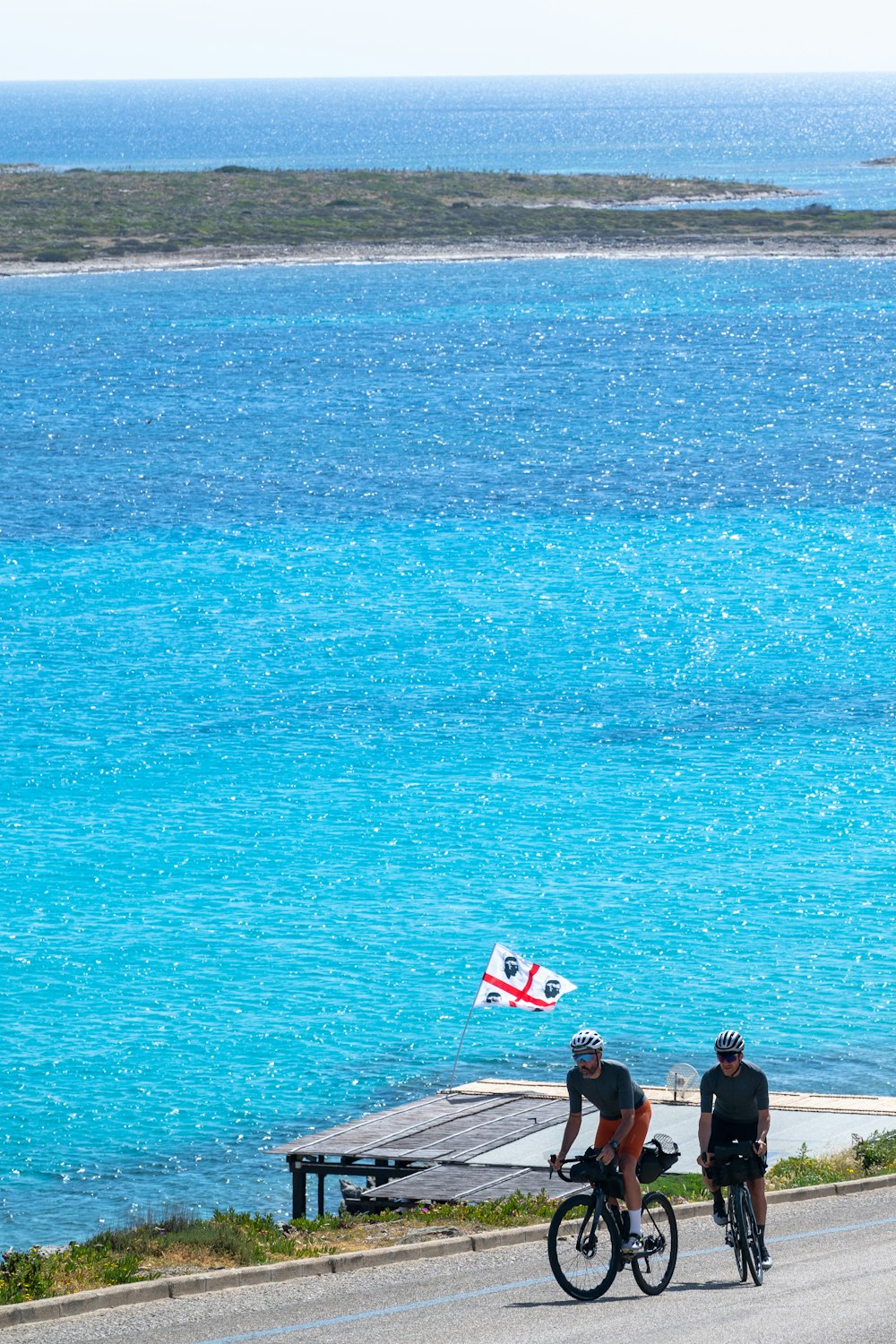
Plus, there is the romantic side, which is obviously the most important: it may be the genes of who knows what sailor ancestor, it may be the stories read over and over of explorers and navigators, but leaving land on a boat always has a greater charm. It really is a getaway, a departure from all that one knows, relying on the waves and their mystique. Setting sail is a ritual, even if you are on a very comfortable motorised ferry with two restaurants on board, a bar open round the clock and every convenience, including live coverage of Bayern Munich – Real Madrid, the Champions League semi-final.
The beach of La Pelosa, in Stintino, is the goal of the first day on Sardinian soil. Not far from Porto Torres, it is one of those places I have always heard about: in good terms because of its beauty, and in bad ones as it has become terribly overcrowded in the summer season. Or, at least, these are the considerations handed down by cycling traveller friends, intolerant to all that is commotion. Once there, the scenario we are presented with is one we will never forget. It is difficult to sum it up in a word, or even a sentence or a paragraph.
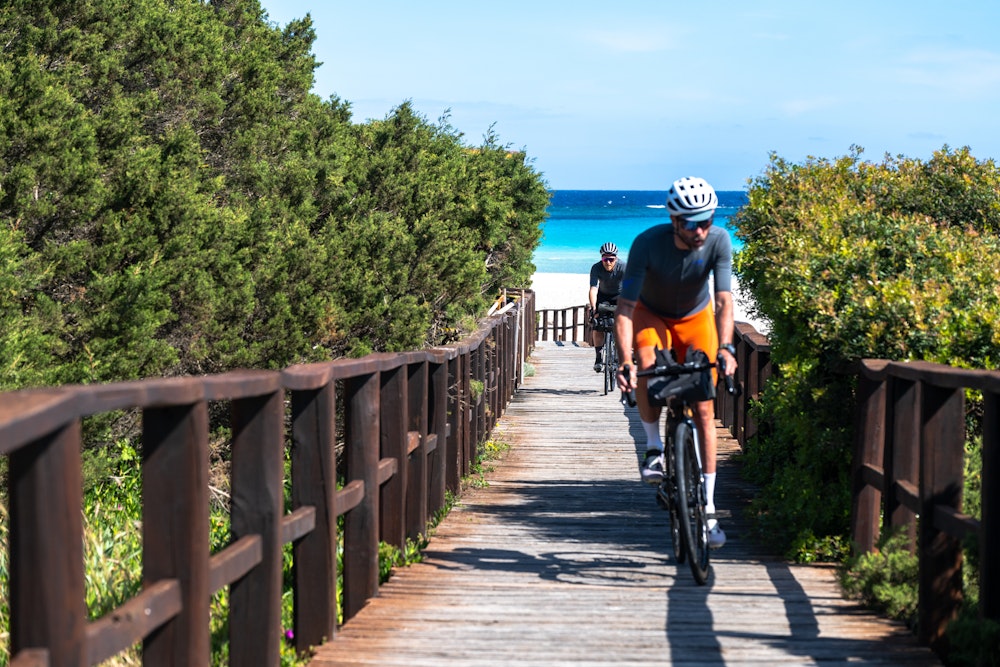
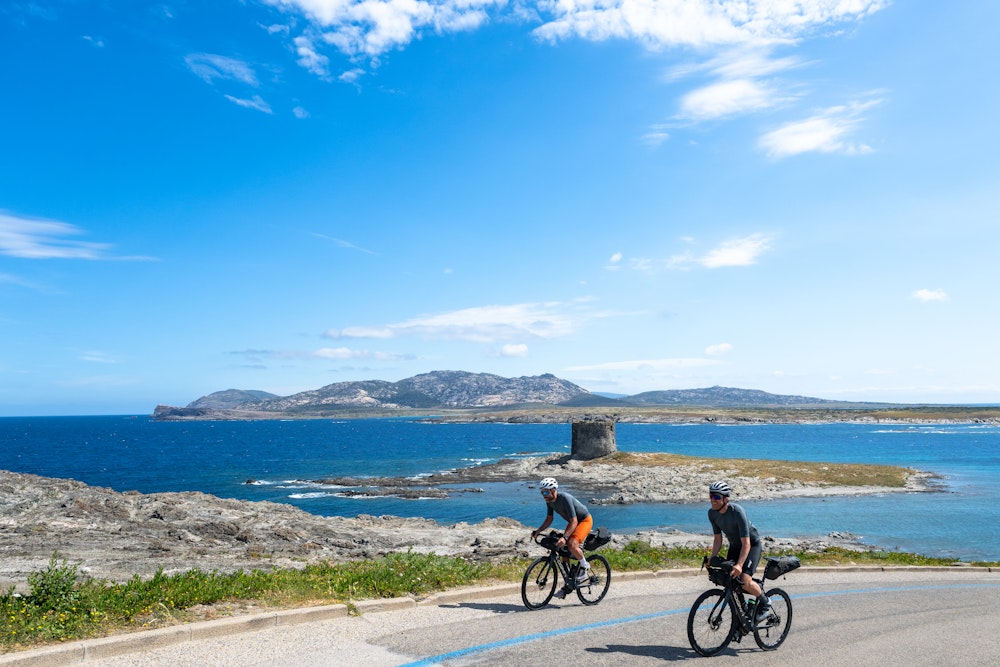
The silence, the tranquillity, the peace, the colours so bright they seem to have just been placed on a canvas by some impressionist painter. We exchange a few words, but really just a few: beauty fills every space and we remain still, transfixed. Travelling in May, sacrificing the summer holidays, is anathema for us Italians. Personally, I think it’s anathema, not to enjoy such a place, at a time like this. These are considerations that probably only those who are used to moving around with their essentials stuffed in a bag strapped to a bike can understand.
The choice to scout the west coast was not random. I liked the idea of crossing several territories, several areas, and doing so with a common thread uniting the whole trip: in this case, the Sardinian Sea. I wanted the sun to go off to sleep every night, disappearing before our eyes, diving into the horizon of the Mediterranean which, in these parts, is not always friendly. An often windy Mediterranean, a real Mediterranean, with a real sea flavour.
Alghero is the first major town we pass through and where, of course, we decide to make a pit stop. It has the good fortune of not being too big, so there are none of that dull and, alas, all too often decadent outskirts. The walls defending the city, overlooking the sea, are warm and comfortable, definitely recommended for spending a good twenty minutes with your feet dangling off the side. It is easy, from there, to imagine the heroes of ancient times gazing at the horizon in anticipation of the incoming enemy, or discussing the exploratory mission that was about to begin.
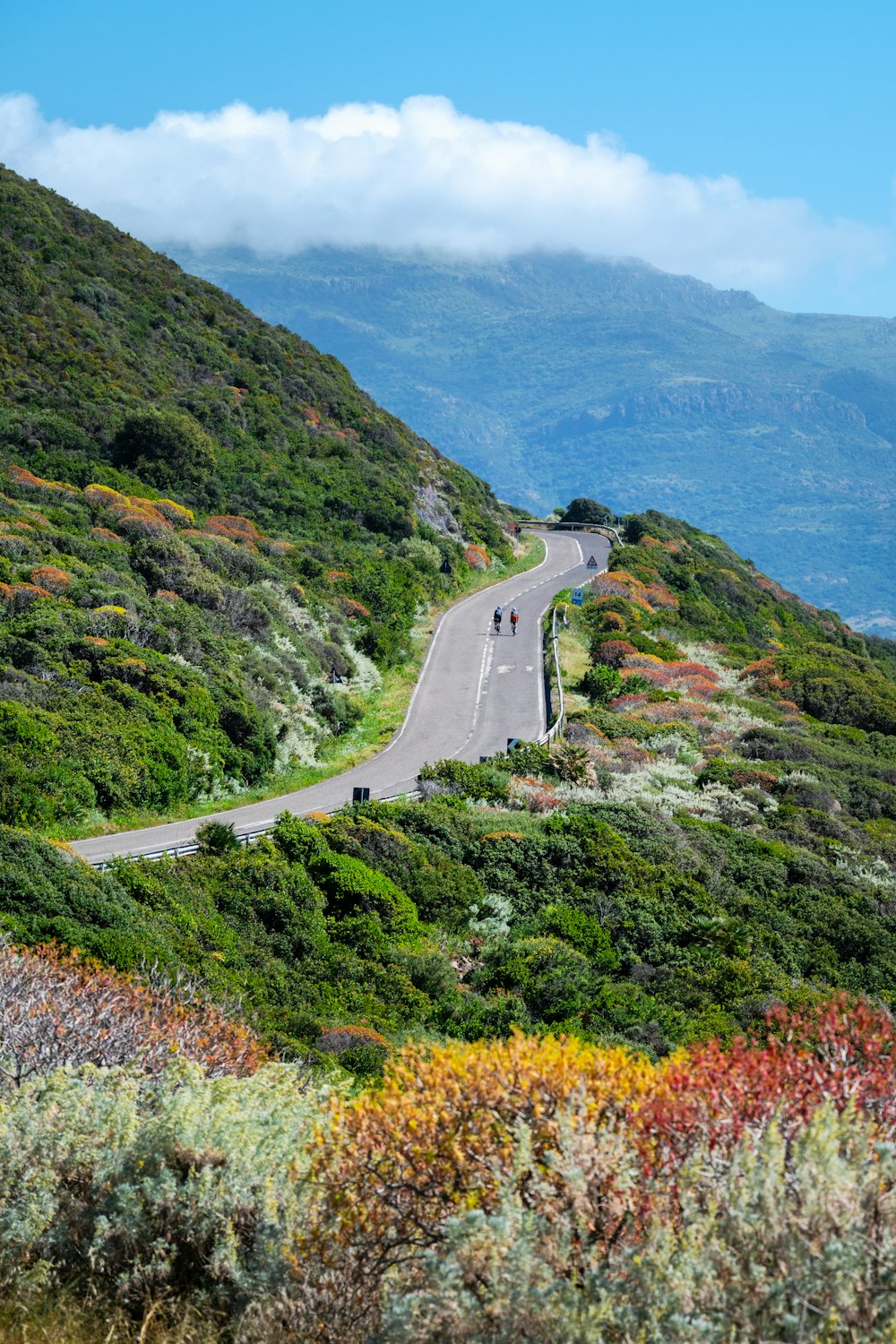
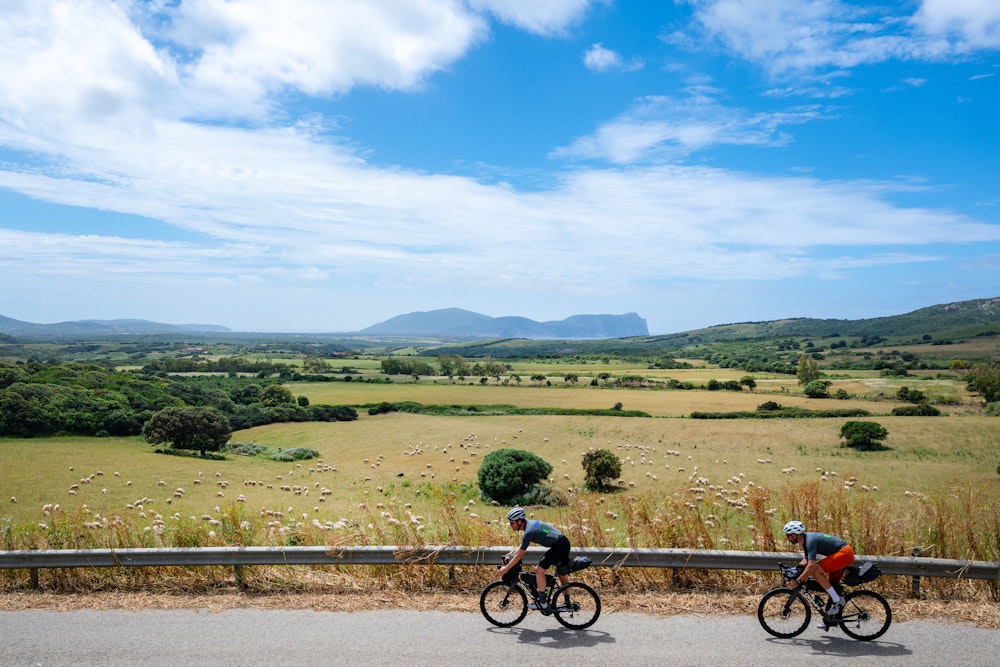
There’s practically no traffic, the temperature is just right, the sun slowly begins to go down while our legs are still happily spinning, the sound of the waves from the right and some griffon vultures above our heads, almost as if to escort us on this journey that seems truly timeless. I begin to think about what brought me here, about my motivations, about the image I have of this land, and once I reach my destination, watching the first sunset over the sea, I realise that I am on the right track.
It's been an unusual spring, the wettest in recent years, which is why Sardinia displays a vividness of colour that I would never have imagined. Meadows and trees look as if they were recently transplanted from some northern European fjord, so saturated is the green. The sky creates a clear line with the sea, both blue but with a different intensity, thanks also to the wind that blows relentlessly, cleaning the air. The wind, yes, which in these places is a serious thing: Mistral from the north-west, west winds from the mainland, and more rarely, the very hot sirocco directly from Africa. Proceeding from north to south, the probability of the current pushing us along is definitely high and, it might just be our good fortune, but the best predictions also come true on this second day. The wind is in our sails and our cruising speed is definitely high, considering that this is a trip and not a cyclosportive, which helps us to cover more quckly the stretches where we feel like hitting the gas, so that we can take our time whenever we feel like it.

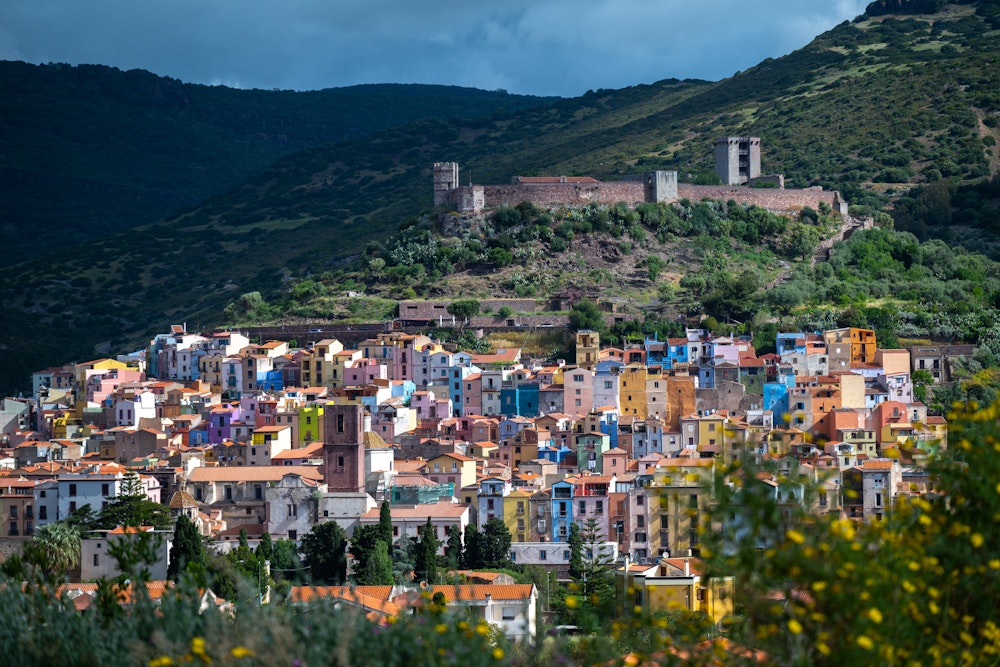
So, we often meet locals whom we deliberately tease, trying to engage in some kind of conversation, with the aim of delving deeper into the knowledge of this land: there is no better way to do this than to come into contact with human beings. Sardinians are a decidedly proud people, and this is nothing new, if you just think of how many flags with the four Moors one is used to seeing, in every situation and in every corner of the world: from Bruce Springsteen's concerts in Copenhagen, to remote bars in some southern hemisphere town, Sardinians are there and like to show it. Stubborn people, and this too is nothing new. People oftned described as closed and distrustful: and here, I can say without reserve, that this is some of the biggest lies I have ever heard. While it's true that you shouldn't lump everything together, it's also true that I've rarely found people so helpful over the thousands of kilometres I've ridden in the last fifteen years.
The names of the cities here will often bring a smile and one can’t help waiting to repeat them over and over, but first you have to learn to pronounce them correctly: sometimes they sound like tongue twisters and that’s why you need a little help from the locals. Mrs Giovannina comes to our aid in understanding where the emphasis goes in names like Magomadas and Tresnuraghes. She thought it best to tell us her story as an emigrant who left Sardinia and then returned to her homeland, and of the identical route travelled by her husband, her two sons and finally also her grandchildren. Almost as if it were a sort of price to pay: to go and, only then, to be able to return. We spent over half an hour chatting with Giovannina, covering various topics and even gathering tips for cooking malloreddus, preparing a good sauce, and preserving pecorino cheese in the best possible way: so much for the distrust and closed-mindedness of these people.
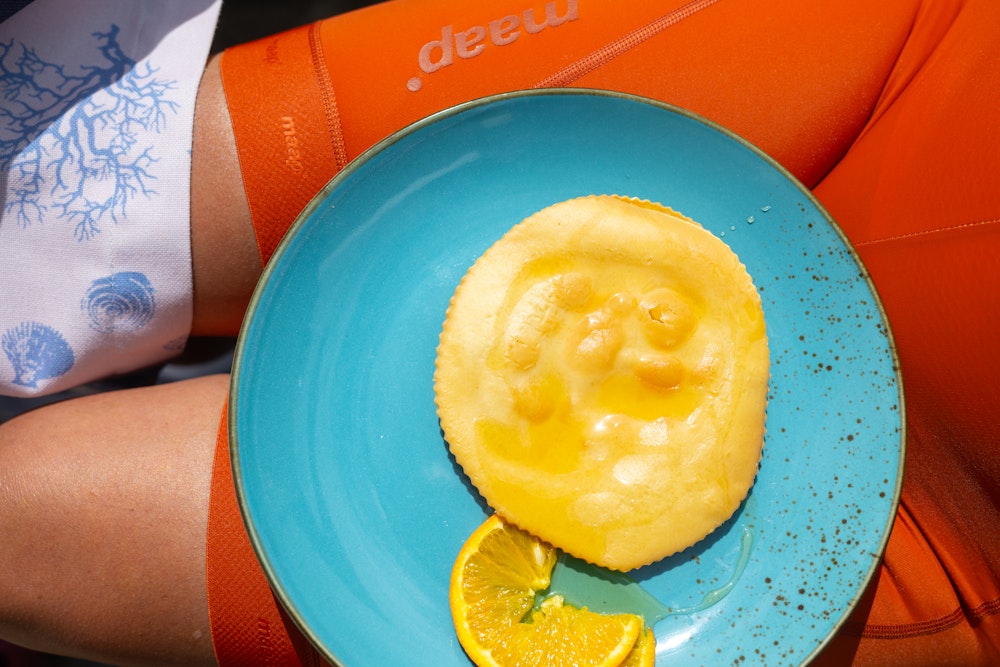
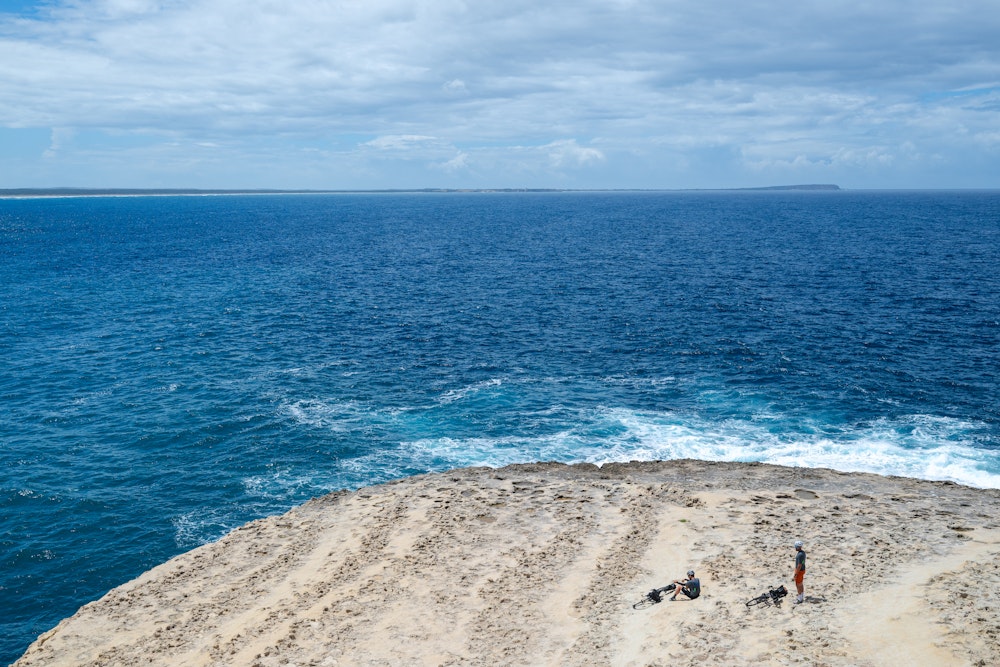
We cylce, steadily and inexorably, southwards. The colour of the sea changes, and so does its function, giving it ever-changing roles: from a place for holidays to a place for fishing and sustenance, to a wonderful open-air gym for the new generation of surfers. Stuff that was unthinkable thirty or forty years ago. And, with the sea, the landscape all around also changes, showing lakes, forests, corn plantations stretching as far as the eye can see, like Louisiana in the movies. Then, finally, our second sunset.
The food, as all over Italy, is not taken lightly here: the fish along the coast, the dairy heritage, the inland dishes, there are a myriad alternatives and all delicious. However, what has always intrigued me most is the traditional tuna fishery in Carloforte, on the island of San Pietro. The schedule is quite tight, but in the travel programme we decided to include an excursion to the island within the island, our destination for the third leg, with three objectives: to test, understand and enjoy.
The day starts out like this, with this focus clearly in mind but, as the wise men teach us, it is a big mistake to think only of what is to come, instead of dwelling on the moment one is experiencing. As usual, the road on which our wheels have been rolling for three days now jolts us back to the here and now. The asphalt strip that leads to the Bidderdì Pass, the deserted seafront of Portixeddu where we can’t miss a quick swim, the cooling rain at Buggerru, the mining villages, the Sugarloaf Mountain and the stacks of Masua, the oceanic beach of Fontanamare. It’s a succession of emotions bestowed by the simplest yet most important, but often forgotten thing we have at our fingertips: beauty.
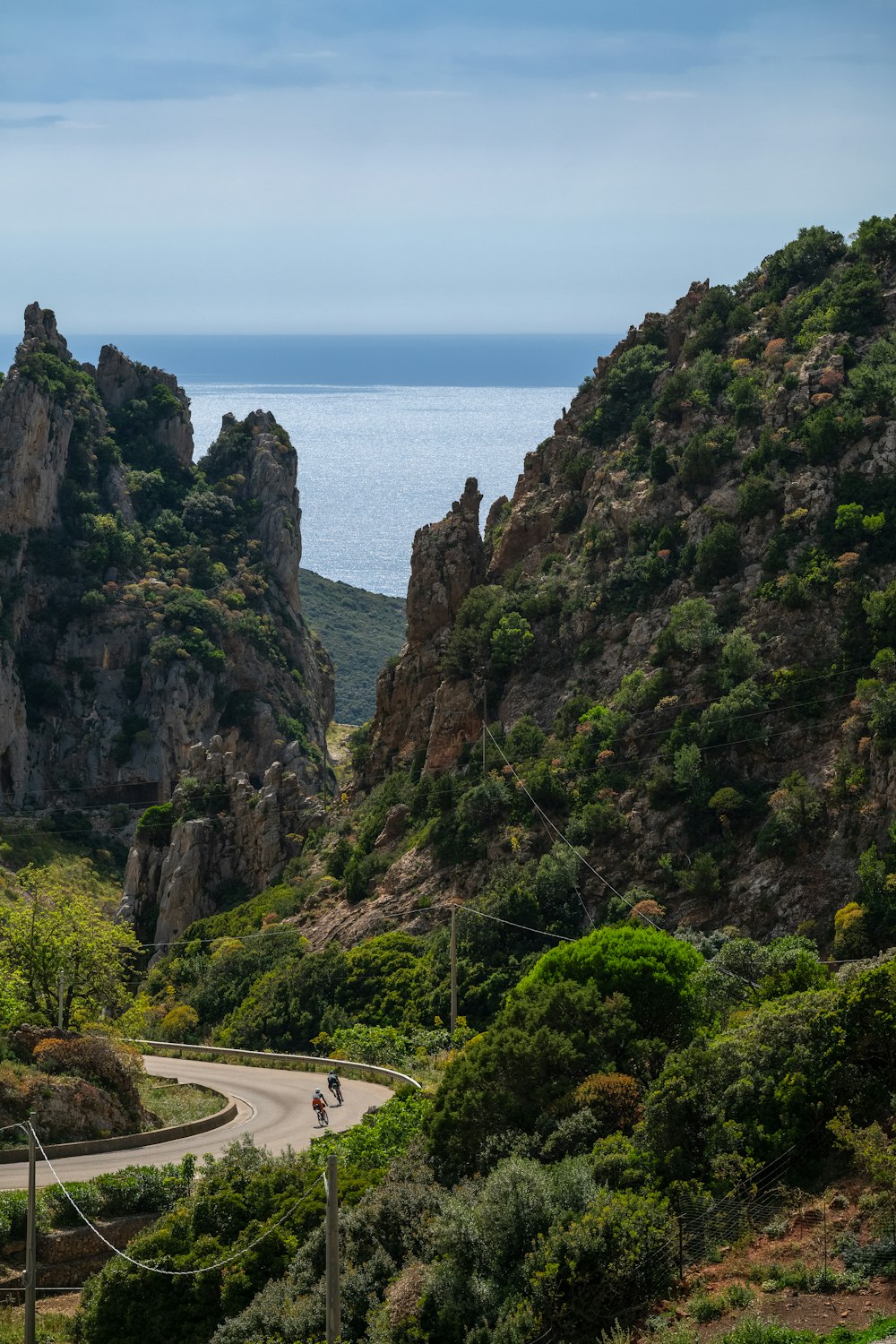
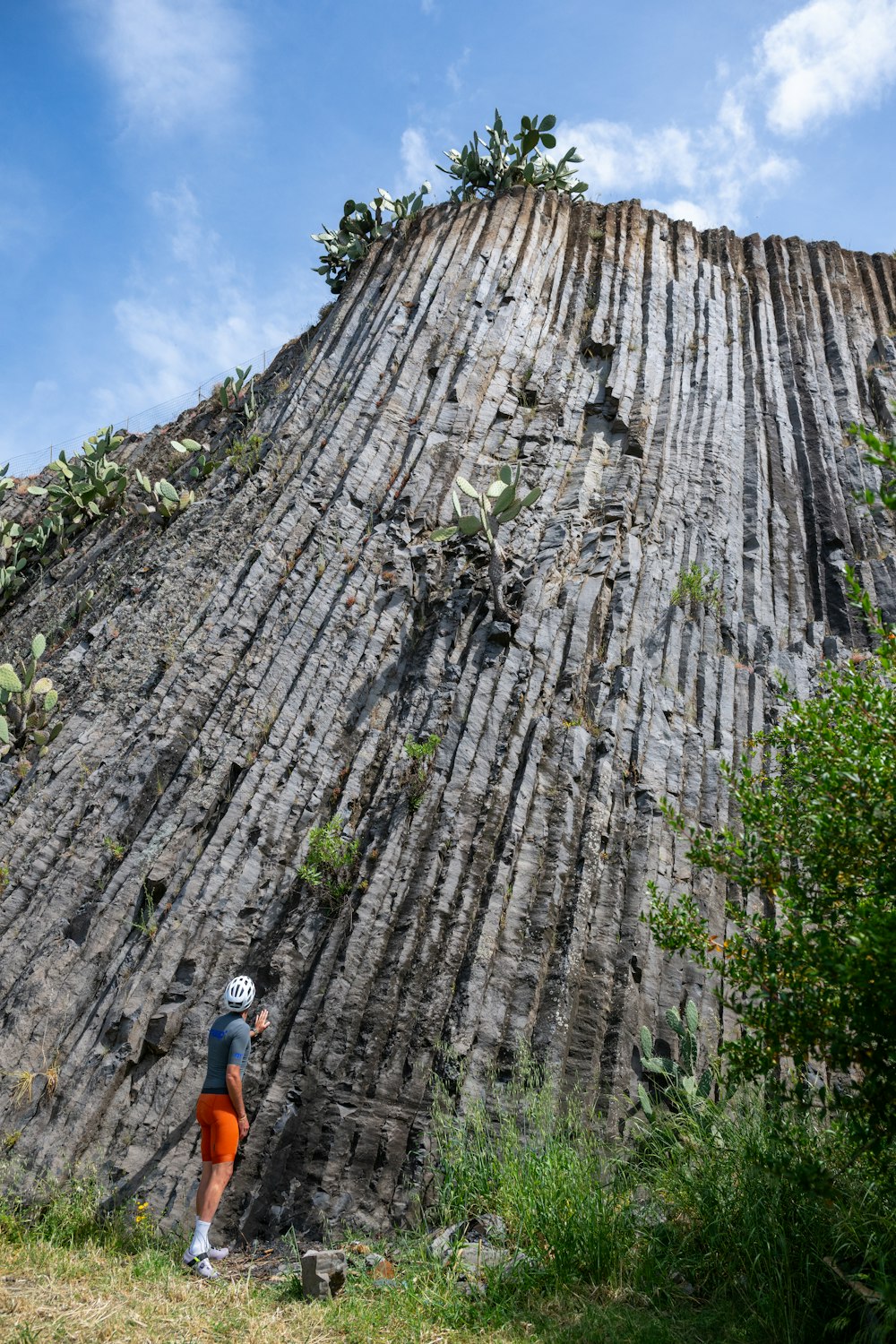
We don’t talk much on this trip, at least not as long as we are on the saddle. Thus, the arrival at the ferry boarding point also marks the moment when we can start chatting freely. Yet, even this time, the sailing effect kicks in and brings our words to a halt, leaving room for yet another moment of contemplation. In this way we arrive in Carloforte, with the third sunset as a gift, sipping a well-deserved beer at the end of the day, on a ferry frequented only by commuters shuttling between the two islands. I am more and more certain of being on the right track.
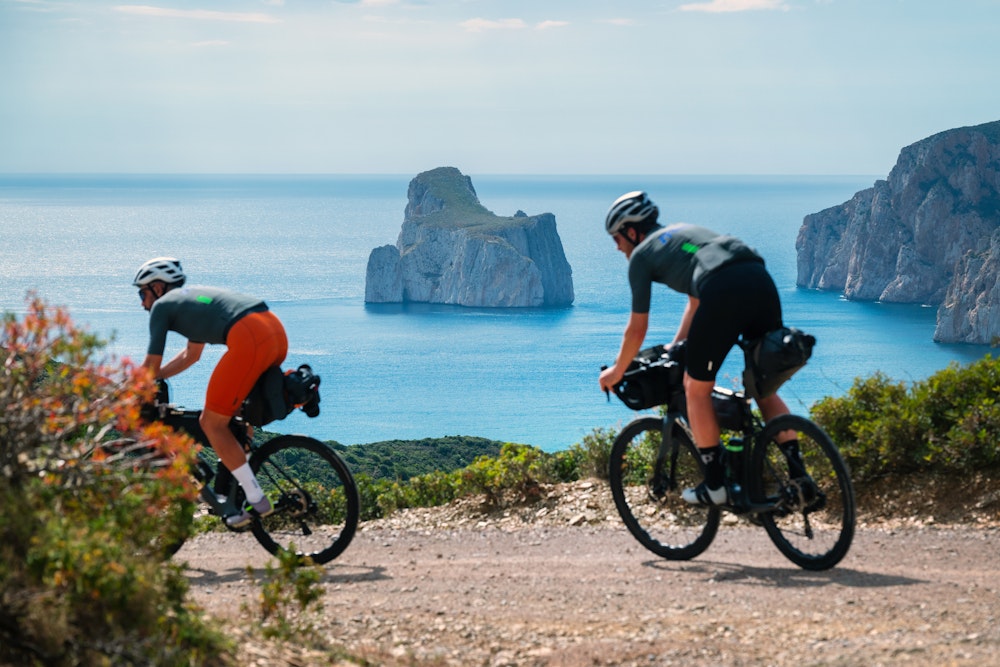
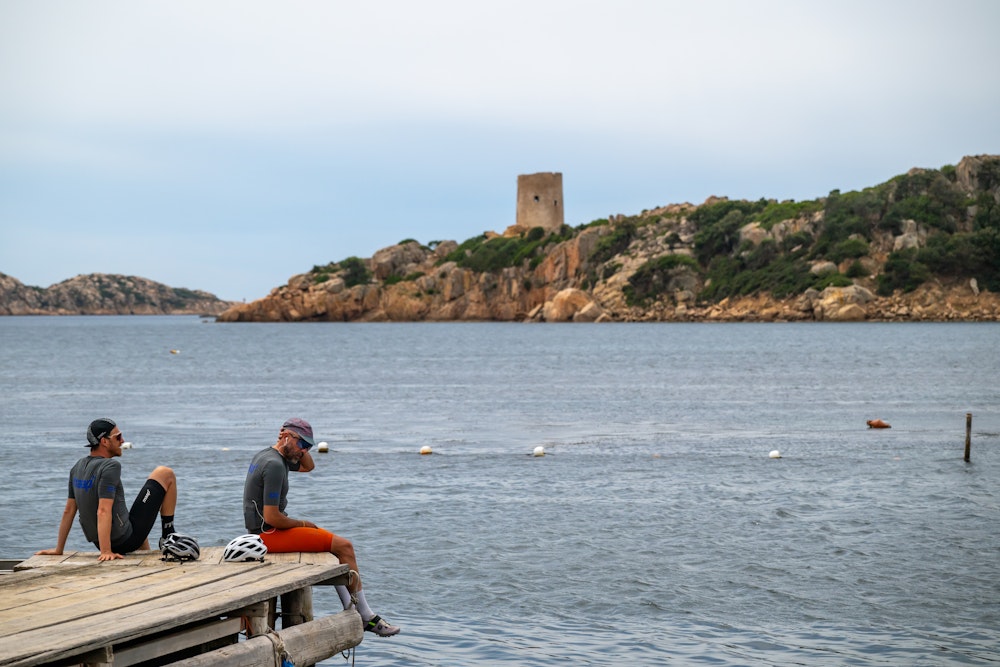
Carloforte is a special place. It is located in Sardinia, in the far south-west, and can be reached in half an hour by boat. It is a famous municipality made unique by two things: its Ligurian origins and the tuna fishery. You only have to take a few steps around the centre to notice the architecture, hear the dialect, and realise that there is something strange here: it feels like being on the Riviera, it doesn't matter if west or east, but it is definitely Ligurian. We are told that it all started around 1730, when a large number of fishermen from Pegli, confined to the Tunisian island of Tabarka, were allowed to colonise the then uninhabited island of San Pietro and settle there. So much so that, even today, the slang is that of the caruggi (narrow alleyways typical of Liguria) and it is not surprising if you hear the occasional belin (the typical Ligurian interjection) from the mouth of the tobacconist or greengrocer in the piazza. As far as tuna fishing is concerned, on the other hand, it’s all a lot simpler: in these waters tuna thrives, proliferating, and the fishing tradition confirms this. Canned tuna, tuna fillets, raw or lightly seared but never well-cooked, and of course pasta with tuna.


These days in Sardinia are bringing us a host of discoveries we could not have imagined. We discuss all this on a morning in May while, between one bend and the next, we cycle along the southern coast that will take us to Cagliari. It seems unreal to us to be able to chat while we cycle next to each other, without cars ready to honk and shout at us while overtaking only to gain a few crucial seconds in grabbing the best spot on a crowded beach on a hot August day. I will never get tired of repeating how typical mass tourism is a disease, completely at odds with what we are experiencing, in low-season, riding a bike.
We enjoy the last pedal strokes, once again in silence, waiting for our fourth sunset. We choose to climb up to the Bastione di Santa Croce, in the heart of the capital, to experience this moment from above, once again identifying with some hero from another era who, from up here, would scan the horizon. There is an unfamiliar Sardinia, where noisy yachts, starched white shirts and sometimes vulgar club booths make way for silences, sunsets and tank tops creased by noble professions. There is an authentic, proud, helpful and welcoming Sardinia. There is a Sardinia just like the one I used to imagine as a child: mythological, alive and ready to amaze. If you decide to lose yourself in this far west, you too are on the right track.
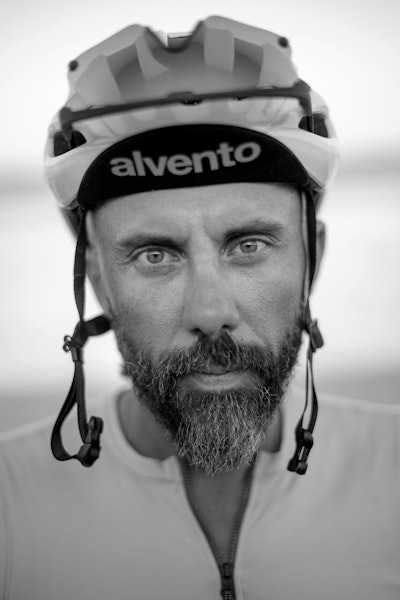
Texts
Stefano Francescutti
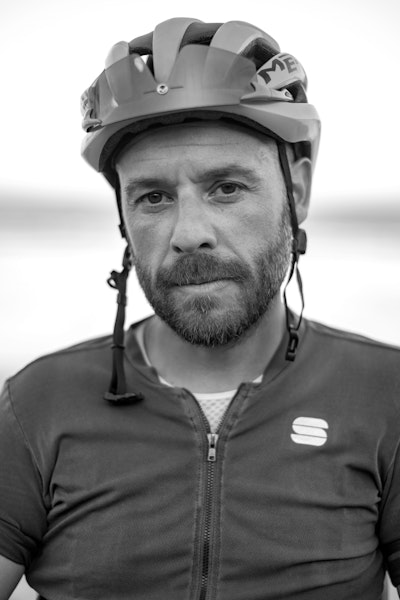
Photos
Paolo Penni Martelli
Cycled with us
Stefano Francescutti, Claudio Ruatti
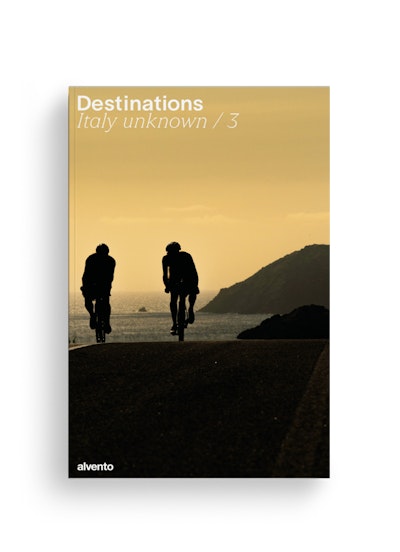
Questo itinerario lo puoi trovare sul super-magazine Destinations – Italy unknown / 3, lo speciale di alvento dedicato al bikepacking. 9 destinazioni poco battute o reinterpretazioni di mete ciclistiche famose.
